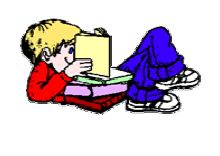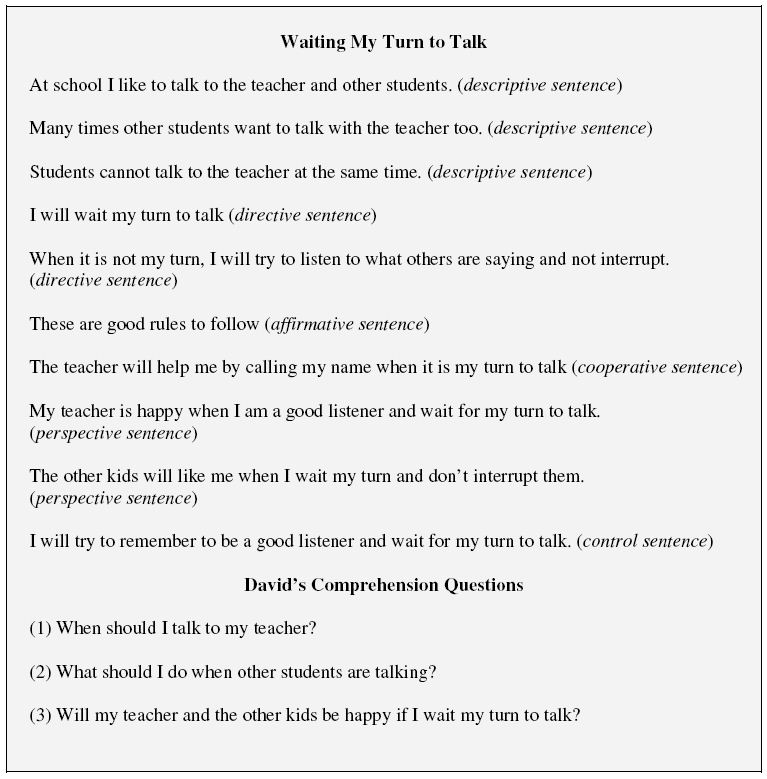Social Stories: An Emerging and Effective Intervention for Students with Autism Spectrum Disorders (ASD)
By: Lee A. Wilkinson, PhD, NCSP

Over the past decade social stories have shown promise as a positive and proactive classroom strategy for teaching social skills to children with autism spectrum disorders (ASD). They continue to be widely discussed, reviewed, and recommended as an effective and user-friendly behavioral intervention. Social stories allow the child to receive direct instruction in learning the appropriate social behaviors that are needed for success in the classroom setting. The simplicity and utility of social stories make them a popular choice for use in both general and special education settings.
What is a Social Story?
A social story is a short story that is written in a child specific format describing a social situation, person, skill, experience, or concept in terms of relevant cues and appropriate social behavior. The objective of this intervention strategy is to enhance a child’s understanding of social situations and teach an appropriate behavioral response that can be practiced. Each story is designed to teach the child how to manage his or her own behavior during a specific social situation by describing where the activity will take place, when it will occur, what will happen, who is involved, and why the child should behave in a certain way. In essence, social stories seek to answer the who, what, when, where, and why aspects of a social situation in order to improve the child’s perspective taking. Subsequent social interactions allow for the frequent practice of the described behavioral response cue and the learning of new social behavior. Although a number of commercial publications offer generic social stories for common social situations, it is best to individualize the content of the story according to the child’s unique behavioral needs.
Writing a Social Story
Social stories follow an explicit format of approximately 5 to 10 sentences describing the social skill, the appropriate behavior, and others’ viewpoint (perspective) of the behavior. These sentences are written according to comprehension level of the child and include the following basic sentence types.
- Descriptive sentences which provide statements of fact and objectively define the “wh” question of the social situation.
- Directive sentences that describe the desired behavior and generally begin with “I will work on” or “I will try.”
- Perspective sentences which describe other individual’s reaction and feelings associated with the target situation.
- Affirmative sentences which stress a rule or directive in the story.
- Control sentences that help the child to remember the directive.
- Cooperative sentences that describe who will help and how help will be given.
The social story should be written in a way that ensures accuracy of interpretation, using vocabulary and print size appropriate for the child’s ability. Pictures illustrating the concept can be included for children who have difficulty reading text without cues. They can be simple line drawings, clip art, books, or actual photographs. An example of a social story (text only) is provided at the end of this article.
Implementing a Social Story
Social stories should not be used in isolation and are not intended to address all of the behavioral challenges of the child with ASD. Rather, they should be integrated into the student’s IEP or behavior support plan on a daily basis to complement other interventions and strategies. When the social story is first implemented, the teacher must be certain that the child understands the story and social skill being taught. The child can then read the story independently, read it aloud to an adult, or listen as the adult reads the story. The most appropriate method is dependent upon the individual abilities and needs of the child. Regardless of how the story is implemented, it is necessary for comprehension of the story to be assessed. Two approaches are recommended. The first is to have the student complete a checklist or answer questions in at the end of the story. The other is to have the student role play and demonstrate what he or she will do the next time the situation occurs. Once comprehension has been assessed, a daily implementation schedule should be created. It should be noted that there are no limitations on how long a student can use a social story. Some students will learn a new social behavior quickly while others will need to read their stories for several weeks. A critical feature of implementing a social story is monitoring student progress and collecting data to evaluate improved social outcomes. The following steps are recommended when developing and implementing a social story intervention.

Effectiveness of Social Stories
As we know, there are no interventions or treatments that can cure autism. In fact, there are very few that have been scientifically shown to produce significant, long-term benefits for children with ASD. Although the published research on social stories provides preliminary support for their effectiveness in reducing challenging behavior and increasing social interaction for children with ASD, it is uncertain whether they alone are responsible for long-lasting changes in social behaviors. Other strategies (e.g., reinforcement schedules, social skills training) implemented together with social stories may be required to produce desired changes in social behavior. As a result, social stories should be included as part of a multicomponent intervention in the classroom setting. While further outcome research is needed, social stories may be considered an emerging and potentially effective approach for facilitating social skills in children with ASD.
Example of a Social Story
David, a second grader with ASD, has a difficult time waiting to talk with his teacher, repeatedly speaks out of turn and interrupts other students. When told to wait, he frequently experiences a “meltdown” and refuses to cooperate. His teacher developed a social story called “Waiting My Turn to Talk.”

Study Questions
- List the basic steps in developing a social story intervention?
- How are social stories implemented?
- What does the literature say about the effectiveness of social stories?
- Describe the rationale for using social stories with students with ASD?
- Discuss the advantages and limitations of using social stories in the classroom?
Recommended readings and resources:
http://www.thegraycenter.org/
Crozier, S., & Sileo, N. M. (2005). Encouraging positive behavior with social stories: An intervention for children with autism spectrum disorders. TEACHING Exceptional Children, 37, 26-31.
Gray, C. A. (2000). Writing social stories with Carol Gray [Videotape and workbook]. Arlington, TX: Future Horizons.
Gray, C. A. (2000). The new social story book. Arlington, TX: Future Horizons.
Gray, C. A. (2002). My Social Stories Book. London: Jessica Kingsley Publishers.
Sansosti, F. J., & Powell-Smith, K. A. (2006). Using social stories to improve the social behavior of children with Asperger syndrome. Journal of Positive Behavior Interventions, 8(1), 43–57.
Spencer, V. G., Simpson, C. G., & Lynch, S. A. (2008). Using social stories to increase positive behaviors for children with autism spectrum disorders. Intervention in School and Clinic, 44, 58- 61.
Featured Author: Lee A. Wilkinson, EdD, PhD, NCSP
Lee A. Wilkinson, EdD, PhD, NCSP is an author, applied researcher, and practitioner. Dr. Wilkinson is currently a school psychologist in the Florida public school system where he provides diagnostic and consultation services for children with autism spectrum disorders and their families. He is the author of the award winning book “A Best Practice Guide to Assessment and Intervention for Autism and Asperger Syndrome in Schools” published by Jessica Kingsley Publishers. Dr. Wilkinson can be reached at http://bestpracticeautism.blogspot.com.
PediaStaff is Hiring!
All JobsPediaStaff hires pediatric and school-based professionals nationwide for contract assignments of 2 to 12 months. We also help clinics, hospitals, schools, and home health agencies to find and hire these professionals directly. We work with Speech-Language Pathologists, Occupational and Physical Therapists, School Psychologists, and others in pediatric therapy and education.
